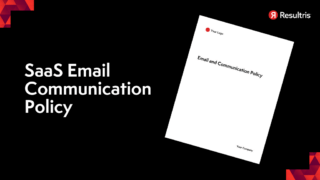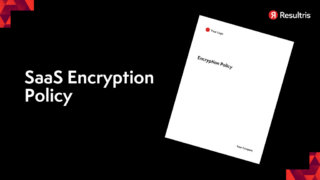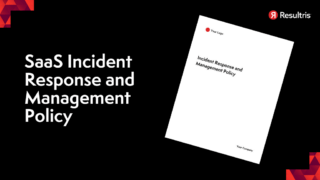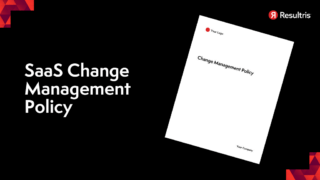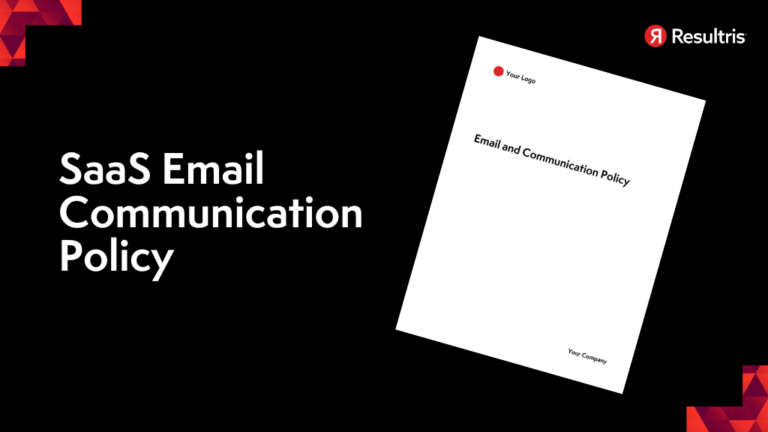
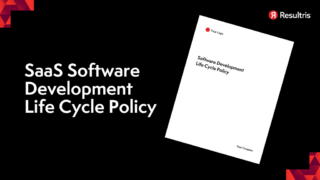
Written by: Tim Eisenhauer
Last updated:

Navigating the world of SaaS can be a daunting task, especially when it comes to email communication policy. It’s an integral part of any business, ensuring smooth and secure communication. But how do you make sure you’re doing it right?
From understanding the basics to implementing SaaS Compliance and Security Best Practices, there’s a lot to consider. This article will guide you through the maze, shedding light on key areas you need to focus on. Let’s dive in and demystify the complexities of SaaS email communication policy together.
Delving into the world of SaaS, email policies prove critical to business operations. Let’s delve into this crucial policy, its aspects, and significance.
A SaaS Email and Communication Policy refers to a set of rules and guidelines, established to govern all email communications within a SaaS company. This policy aims to ensure all communications are professional, clear, and secure, thereby preventing misunderstandings or miscommunications.
In a SaaS environment, this policy extends to cover all digital channels of communication, ensuring every interaction adheres to the established guidelines. This comprehensive policy scope includes interactions with clients, employees, vendors, and partners.
An email communication policy enforces the highest standards of professionalism in all correspondences. It helps regulate email content, format, and tone, affording your brand a distinguished, reliable image.
Your company often deals with sensitive information. An email policy prevents accidental data leaks by putting in place mandatory encryption standards, clear directives on sharing sensitive data, and rigorous measures for dealing with data breaches.
Adherence to an email policy ensures your company stays compliant with regulations applicable to SaaS environments. It helps secure communication channels and data, aiding your business in avoiding legal complications and potential security threats.
Moving ahead from the essence of a SaaS Email and Communication Policy, let’s consolidate our understanding of its key components. We’ll be exploring a series of six pivotal elements that attribute to a substantial policy.
A policy must detail guidelines for acceptable use, defining how employees can use company’s email and communication tools. It’s likely to involve appropriate content, proper email etiquette, and use of communication platforms within work environments. For example, personal use of corporate emails could be frowned upon.
Email security is no trivial matter, given that 94% of malware gets delivered via email as reported by Verizon’s 2019 Data Breach Investigations Report. Your policy might include tips on creating strong passwords, protocols for identifying phishing attempts, and recommendations on two-factor authentication, such as Google’s 2-step verification.
Akin to the pivotal role of customers in business, defining standards for customer communication is another essential element. This part of the policy demonstrates how to maintain professionalism, empathize with customers and address their concerns promptly. Businesses following these standards have seen a clutch of benefits, like that 96% of customers who’ve had their issues resolved quickly and efficiently were likely to do a repeat purchase according to Qualtrics XM institute.
Making clear internal communication protocols is a crucial factor. It defines how employees communicate with each other on professional platforms. Elements might involve when to use email versus instant messaging, and how to conduct virtual meetings. As an instance, employees might be encouraged to use email for formal conversations and turn to Slack for quick, less formal interactions.
In an era where social media has turned into a powerful business tool, having defined guidelines for its usage is critical. This includes instructions on sharing business updates, respect for intellectual property, privacy rights and more. For instance, a good practice might be to avoid posting sensitive company information on social platforms.
An integral part of work environments today, collaboration tools like Slack or Microsoft Teams have made it crucial to set standards for their use. This involves etiquette on sharing files, guidelines on maintaining privacy and considerations for time-zones in global teams. Statistics from IWG show that 50% of employees globally work outside their main office headquarters for at least 2.5 days a week, making clear rules for using such tools an important part of SaaS policy.
By understanding these key components, you’re paving a roadmap towards a comprehensive SaaS Email and Communication Policy.
Just as in any corporate policy, in a SaaS Email Communication Policy, various parties hold specific responsibilities. This section breaks down these roles and each stakeholder’s duties.
The leadership, often the board of directors or the executive management team, bears the burden of establishing the organization’s communication standards. They construct the foundation for all communication policies, fostering a culture of transparency and professionalism. Expressing their expectations, they set the tone, demonstrating how best to navigate email communication. Therefore, leadership’s role is paramount in establishing underlining principles that ensure all stakeholders adhere to the highest standards of communication.
Employees, the primary users of email communication, are key holders in the process. They are obliged to follow the established guidelines, handling all email correspondences meticulously. From ensuring confidentiality, minimizing typos, to maintaining a professional tone, their role is comprehensive. Furthermore, adherence to best practices like double-checking the recipients or verifying attachments ensures a secure communication environment. Thus, employees play a central role not only in sustaining but also in uplifting the communication standards in a SaaS company.
The IT department is tasked with the technical aspects of email communication. They are the custodians of email infrastructure, ensuring smooth operation and ironclad security. Responsible for email setups, configurations, security protocols, and dealing with potential threats, they ensure the safe transmission of sensitive information. Thus, the IT department is an indispensable part of the SaaS email communication strategy, securing business continuity by mitigating potential email security threats.
The customer support team, the interface between the company and its customers, adheres to specific guidelines. Their communication encompass not just clarity and prompt responses, but also empathy and professionalism. Their responses directly reflect the business ethics and values of the company. They balance providing resolutions with maintaining customer satisfaction, amounting to a superior customer experience. Therefore, unique communication guidelines govern the actions of a customer support team in a SaaS environment.
Drafting a SaaS Email and Communication policy involves several steps. In this section, we’ll delve into four primary areas that are crucial for every organization.
Kickstart your policy creation by evaluating the current communication practices in your business. Scrutinize the platforms in use, such as email, social media and collaboration tools. Identify the frequency, tone, and content of messages. Additionally, understand the security measures in place. These insights serve as a baseline for improvement.
Next, bring clarity into your communication operations. Craft guidelines on appropriate use of communication tools, email security measures, and the type of language to deploy. Set requirements for internal and external communication. For instance, customer communication standards could be different from internal protocols. Familiarize your team with these expectations; they form an integral part of your policy.
Ensuring that your policy complies with legal and regulatory requirements isn’t just critical, it’s mandatory. This might include regulations to prevent data breaches, or laws pertaining to customer privacy. Cross-check with local, national, and international legislation to ensure your communication practices aren’t crossing any legal boundaries.
Finally, get your policy reviewed and approved by relevant stakeholders. This includes team leads, the IT department, and perhaps legal advisors. Their inputs can enhance the robustness of your policy while ensuring that all potential communication scenarios have been taken into account. Post-approval, make sure it’s communicated to all concerned parties to ensure seamless integration into business process.
Feeling convinced about the relevance of email communication policies in the SaaS landscape? It’s time to put those insights into action. This section paves the way for effective execution of the SaaS Email and Communication Policy, with focal points being Employee Training and Awareness, Integration with Onboarding Processes, and Regular Policy Updates and Reminders.
Once there’s an email policy in place, the next step isn’t to place it in the company directory and hope for the best. Awareness is key. Not just that policies exist, but understanding their rationale transforms rules from restrictions into revelations about best practices. Transparency about what information is risky to share, or message practices that could hamper productivity, builds trust in the policy’s purpose.
Kick-off an engaging workshop or an online session to give your employees a walkthrough of the email policy. A quiz or interactive activity following the session adds value – earning points or badges for answering correctly would boost memorability of these rules. Remember, emphasizing the positives–better communication, data security, professionalism–brings on board more willing participants in the training process.
Onboarding sets the tone for a new hire’s journey in your organization. It’s the best time to immerse them in the communication culture you’ve established. Don’t forget to embed email policy training as a critical part of the onboarding process.
Share a comprehensive email communication guidebook with new hires. The guidebook, apart from email policy rules, could include email etiquette, writing styles, and even illustrative examples of email exchanges. It’ll be handy for someone who’s trying to familiarize themselves with your company’s communication policy.
Email Communication policies aren’t carved in stone. They’re living documents that need to be reviewed and updated to keep pace with changing technology, legal requirements, and business needs. Establish an annual review process involving key teams – IT, HR, legal – who have a stake in this policy.
Additionally, periodic reminders about the policy aid reinforcement. These could be through emails, demonstrate the principles in action, or bite-sized informational videos. It’s not about policing but promoting adherence to a culture of sound, safe, and effective email communication.
Continuing our odyssey into the world of SaaS email communication policies, let’s delve into some of the best practices for effective communication within SaaS organizations. These vital strategies aim at enhancing professionalism, data security, and overall productivity.
Immaculate email etiquette reflects your organization’s professionalism. From the greeting to the closing, every email sent represents your business. Attach a professional signature, always include a subject line, and keep the content brief yet detailed. Remember to revise emails before hitting “send”, catching misspelled words and grammatical errors depicts attention to detail. Also avoid using caps lock; it’s often interpreted as shouting.
In the era of cyber threats, ensuring the secure handling of sensitive data in your emails has become indispensable. Regularly update your team on the latest privacy regulations and remind them to keep private data like customer’s information secure. Never share passwords or confidential details over emails. Use authentication codes and encrypted attachments for enhanced security.
In SaaS companies, collaboration tools like Slack, Asana, or Trello contribute to efficiency. Make sure your team understands how to use these tools effectively. Streamline communications, assign tasks, and manage projects through these platforms, instead of overloading the email inboxes. Integrate these tools into your email systems for easy access and seamless workflow.
Lastly, email overload can hamper productivity. Apply the ‘Inbox Zero’ strategy, encourage team members to keep their inboxes clean, archive old messages, and filter spam. Set clear expectations for when responses are necessary, you don’t need to answer every email instantly. Prioritize and categorize emails to facilitate time management.
By implementing these best practices in your communication policy, you’re forging a path towards a comprehensive and secure email environment.
Diving deeper into the heart of security, let’s investigate the technical dimensions of email and communication safety. These guidelines clarify sophisticated security measures, from encryption to multi-factor authentication.
Email encryption is a practice central to protecting sensitive data in transit between sender and receiver. Think of it as coding your letters so only the intended recipient can decode and read them. Renowned algorithms include Advanced Encryption Standard (AES) and Rivest-Shamir-Adleman (RSA).
Moreover, authentication measures like DomainKeys Identified Mail (DKIM), Sender Policy Framework (SPF), and Domain-based Message Authentication Reporting and Conformance (DMARC) authenticate the source of emails, curbing phishing and spoofing attempts. For instance, DKIM uses a digital signature to verify an email’s legitimacy, directing it safely to the recipient’s inbox.
When sharing files, especially those holding classified information, security is paramount. Secure File Transfer Protocol (SFTP) can be a shield in these situations, providing an encrypted channel for file transfer.
Cloud-based platforms also offer secure file sharing options. Platforms like Google Drive or Dropbox incorporate advanced security measures, including encryption and two-factor authentication, making file sharing a much safer process.
Setting strong passwords isn’t the end-all security measure. You can take it one step further with Multi-Factor Authentication (MFA). MFA adds an extra layer of security, requiring users to provide two or more verification factors to gain access to resources.
For instance, after entering the password (knowledge factor), an OTP (one-time password) sent to the user’s mobile device (possession factor) might be required. Some organizations may even use biometrics, such as fingerprint scans (inherence factor), for access.
In the age of smartphones, managing mobile device communication is essential. Mobile Device Management (MDM) software allows organizations to secure, monitor, and manage employees’ mobile devices used for work purposes.
Key features often include password enforcement, device encryption, and remote wiping capabilities. Thus, in case of device loss or theft, MDM assists in protecting sensitive data.
Overcoming difficulties in SaaS communication management might seem daunting, but it’s feasible. Let’s unravel the key challenges below.
A crucial challenge in SaaS communication management involves securing the delicate balance between transparency and confidentiality. Companies strive to foster open communication that promotes collaboration and trust. Yet, revealing too much might risk divulging sensitive data. This tug-of-war requires careful judgement and set guidelines to protect proprietary information while promoting an open communication culture.
To achieve this equilibrium, incorporate secure communication tools that offer end-to-end encryption. Employ role-specific accessibility to limit the exposure of sensitive data. For example, CRM tools like Hubspot or Salesforce provide user permission levels that restrict data access depending on roles.
Envision a virtual meeting with a team spread across different time zones. Sound challenging? It often is. With SaaS teams often scattered globally, coordinating communication becomes a test of planning and time management.
Effective management of such communication calls for innovative software solutions like World Time Buddy, which ease your scheduling confusion. This tool helps sync global clocks, resulting in fewer scheduling errors. Additionally, using asynchronous communication methods, such as emails or project management platforms, keeps everyone updated, without having to be available simultaneously.
As remote work propels, ensuring compliance with regulatory requirements becomes a hurdle. Breaches can lead to severe regulatory fines, reputational damage, and loss of trust. Adhering to regulations like GDPR (for EU regions) and HIPAA (for healthcare) is key.
Adopt compliance tracking tools such as ComplyUp or Compliance Manager by Microsoft. These software solutions offer comprehensive compliance frameworks that capacitate your SaaS company to meet multiple regulations, thus mitigating data threats and avoiding non-compliance penalties.
Implementing an email communication policy is just half of the battle in a SaaS company. The other half? Tracking its effectiveness. Assessing your policy’s impact involves scrutiny of Key Performance Indicators(KPIs), email security incident metrics, and monitoring employee compliance and adoption rates.
Clarity lies in numbers. Measuring the effectiveness of your communication policy does too. A crucial part of policy assessment focuses on your chosen Key Performance Indicators (KPIs). It’s paramount to identify specific KPIs that reflect your business goals. Examples of KPIs may include email response times, the number of emails sent, and internal data breach incidents. Observe these metrics over time; a decreasing average response time or a reduced number of data breaches correlates to a successful communication policy.
Your safety is paramount in a digital world. Hence, tracking email security incident metrics remains a cornerstone of policy effectiveness measurement within SaaS companies. Instances like cybersecurity threats, phishing attempts, and information breaches throw light on the robustness of your email policy. An effective policy results in a consistent decrease in such incidents.
Let’s be honest, the success of a policy isn’t just in its formulation. It’s in its implementation. Reviewing the employee compliance and adoption rates gives you a precise perception of policy acceptance. Employ compliance tracking software to note the adherence of each team member to the laid-out email norms. Higher adoption rates reflect the success of your email communication policy. Remember, a policy is only as good as its execution.
The incorporation of legal and regulatory considerations forms a crucial part to achieving an effective SaaS email communication policy. These considerations vary, encompassing data protection laws, industry-specific regulations, as well as e-discovery and record retention requirements.
Operate your SaaS business within the provisions of data protection laws such as the General Data Protection Regulation (GDPR) and California Consumer Privacy Act (CCPA). The former, a European Union legislation, focuses on data protection and privacy, while the latter gives Californian residents specified rights regarding their personal data. These laws dictate how to handle, store, and transfer personal data of customers. Breaching these regulations can lead to hefty fines and damage to the company’s reputation.
Industry-specific regulations like the Health Insurance Portability and Accountability Act (HIPAA) for healthcare industries, and Financial Industry Regulatory Authority (FINRA) rules for financial services, also impact SaaS email communication. For instance, healthcare SaaS vendors need to ensure their email communication is HIPAA-compliant, keeping patient information private. Similarly, financial service firms must fulfill FINRA’s fair and balanced communication requirements.
Besides the above, be aware of e-discovery and record retention requirements. These mandate maintaining electronic data, such as email communications, for a specified period for potential legal cases. Ensure your SaaS company complies with such rules, using good record management practices to carry out all communication activities. Failure to meet these requirements can result in legal and financial implications. Therefore, investing in suitable solutions that help manage email data correctly is a wise course of action.
Navigating through adversity is an integral part of your SaaS company’s journey. Whether it’s managing a security breach, a service outage, or communicating significant changes, effective crisis communication is crucial. Consider the following guidelines for better crisis management communication.
In the event of a security breach, it’s pertinent to understand that damage control starts with effective communication. Start by identifying affected stakeholders – this can range from internal employees to customers or third-party vendors. Once identified, disclose the issue as soon as it’s feasible. Remember, honesty fosters trust.
Document the incident, highlighting the cause, impact, and the steps your SaaS company’s taken to rectify it. It’s also vital to update your customers regularly until the situation’s under control. Lastly, consider developing a robust incident response plan responsible for preventing future occurrences. An excellent example of a company that handled a similar situation well is Sony, when they experienced a significant breach in 2011.
Change, while necessary for growth, can provoke uncertainty amongst your customer base. Thus, tactful communication is essential to assure customers during major transitions.
Begin by communicating the reason for the change, how it benefits the customer, and the expected timeline of implementation. Furthermore, address any concerns your customers may have, and be transparent about potential challenges during the transition. In the SaaS industry, companies like Slack and Trello have managed major transitions commendably, ensuring open lines of communication with their users.
Crisis doesn’t mean chaos. Even during emergencies, consistent and clear internal communication can unify your team and steer your company towards resolution.
Begin by establishing a crisis communication plan that outlines protocols, assigns roles, and sets expectations. Keep your team updated about the progress continually, and ensure that channels for questions and feedback remain open. For instance, companies like Uber and Accenture adopted this approach during the COVID-19 pandemic, ensuring constant transparent communication with their employees.
Equipped with these guidelines, your SaaS Company is prepared to communicate effectively during crises, strengthening your relationship with both your internal team and your customers.
When managing a SaaS business, recognizing the nuances between different business models can be a game-changer. Varying SaaS models demand distinct communication strategies and customer interaction norms. Let’s dig deeper into these variations.
In business-to-business (B2B) SaaS models, the emphasis revolves around facilitating long-term partnerships. Thus, your email communications must instill trust, display authenticity, and demonstrate a deep understanding of the partner’s industry. For example, Salesforce—a prominent B2B SaaS company—tailors its email communication to highlight the benefits it provides to various businesses, using industry-specific jargon and case studies.
On the other hand, business-to-consumer (B2C) SaaS models thrive on mass appeal and personalized engagement. It’s crucial to craft your emails with user-friendliness and accessibility in mind. An excellent instance is Adobe, renowned for its direct-to-customer SaaS products. Adobe’s email communications focus on user experience, providing detailed guides, tips, and tricks to enhance product usage, packaged in a sleek and understandable layout.
Enterprises, with their complex needs, and larger budgets, require a detailed and specialized approach to email communication. It’s important to exhibit a high level of professionalism, reliability, and comprehensive client support in your interactions. Take, for example, Microsoft Azure’s approach to customer interaction, entrenched in technical detail reflecting the complexity of enterprise needs.
Whereas, with small and medium-sized businesses (SMBs), communication tends to be more personal and lean towards practicality. Accessibility and ease-of-use form the crux of the email communication strategy for SMBs. Mailchimp serves as a fitting example. It focuses on fuss-free services, coupling them with easy-to-digest content, and budget-friendly offers.
Remember, adapting your communication strategy based on your business model can significantly enhance engagement, trust, and ultimately, your bottom line. Carefully study your target market and mold your email communication policy to best suit your customers’ needs.
Just as you’ve navigated the intricacies of email etiquette and secure information handling, fresh trends now wave on the horizon. Keep pace, let’s delve into these transformative trends.
Ever imagine email communication being simplified, more predictive and efficient? Well, Artificial Intelligence (AI) is making this a reality in SaaS businesses. Advanced AI-powered tools, such as Grammarly and Boomerang, can enhance your email communications. These tools offer features like real-time grammar correction and email scheduling, making messages clearer and timely, enhancing your communication.
AI also aids in amplifying your customer support. For instance, in situations that demand immediate attention, while you’re juggling other tasks, these tech wonders like AI chatbots can step in to interact with customers, respond to simple queries, and ease off your burden. Examples include IBM’s Watson Assistant and LivePerson, both of which have been instrumental in improving efficiency and customer satisfaction.
Effective communication isn’t always about typed words. Sometimes, it’s about face-to-face interaction, albeit virtually. Platforms like Zoom, Cisco Webex, and Microsoft Teams are proving indispensable in the SaaS industry. However, it’s essential to learn the ropes for an efficient video conferencing setup.
Maintaining professional etiquette remains paramount in video meetings. Ensure you choose a calm background, dress appropriately, and confirm your camera and microphone are functioning correctly. Remember to mute your microphone when not speaking, and importantly, avoid multitasking during meetings, it can be more evident than you think.
Managing larger meetings can be challenging, thus the advent of breakout rooms. Platforms like Zoom now offer breakout rooms where you can divide attendees into smaller groups, facilitating more focused discussions and collaborative tasks.
Remember when real-time communication was the norm? The SaaS realm now embraces asynchronous communication. Asynchronous communication, such as emails, discussion boards and shared task lists, allow interaction without immediate response, offering flexibility and reduced pressure.
With this communication strategy, your teams need not be online simultaneously to work together. Tools like Trello, Asana, or Basecamp can aid in task management while Slack, or even traditional email systems, allow for asynchronous discussions among team members, thereby offering flexible work hours, improved productivity, and reduced burnout. However, clear guidelines on response times should be integrated to avoid sluggishness in communication.
In the evolving digital landscape, global SaaS companies face unique challenges in maintaining effective email communication. Addressing cross-cultural communication norms and adhering to international laws becomes a crucial part of the email communication policy.
It’s essential to respect the diverse communication norms. For instance, in Japan, business communications remain highly formal, requiring honorific titles, while in countries like the US, a more casual approach is often appreciated. Hence, it’s integral to tailor your email communication policy to the cultural contexts of your respective international markets.
International communication laws, notably data privacy and security, exert significant impact on SaaS businesses. With regulations like Europe’s GDPR and Brazil’s LGPD, it’s imperative to ensure that your SaaS company’s email communication policies align with these prevalent laws. For instance, acquiring informed consent from recipients for data collection and processing, as stipulated by GDPR, must be ingrained in your email policy. Thus, global SaaS companies must remain up-to-date with international laws and incorporate them into their email communication strategies to ensure compliance. Engaging legal experts in relevant jurisdictions can play a vital role in achieving this.
When crafting the email communication policy for a SaaS enterprise, synchronization with other corporate regulations becomes key. Here’s how you make it a part of your organization’s holistic governance model.
Successful integration of your company’s communication strategy with its Information Security Policies ensures consistent data security. It aligns the protection protocols with the use of electronic messaging platforms such as emails. Focus on specifics: Firstly, detailing email use for sharing sensitive information like customer details, confidential project information, and internal discussions.
For example, Google’s GSuite platform provides features for classifying email content, detecting potential data leaks, and even restricting e-mail communication based on the classified data. Similarly adopting security measures such as two-factor authentication for e-mail access and regular employee training on identifying potential phishing or spam emails ensures a robust defense mechanism against data breaches.
Tying your company’s email communication policy with its customer service strategies builds a solid rapport with your clients. It helps to set the tone and manner of interaction, crucial in conflict management and resolution.
Consider the Amazon example, the e-commerce giant’s success largely hinges on its strong customer-centric policy. Amazon ensures that all customer-facing emails, be it automated or personalized, always hold certain common elements – courteous language, proper time frame to respond, and direct links to manage their purchases. Ensuring your SaaS communication policy aligns with customer service guidelines, lets you deliver seamless, high-quality customer experiences.
Your branding image is a reflection of your company values, hence incorporating it into the email communication policy is cardinal. Adobe’s “Adobe Always” model provides an apt blueprint of how to align your email communication with your branding image.
Adobe incorporates its brand voice – creative, innovative – across all its email communications which includes sales, customer support, or newsletters. Harmonizing your marketing and branding strategy with your SaaS email communication policy ensures that the brand image is consistently reinforced throughout the entire customer journey. It’s the key to maintaining a unified corporate image across different channels.
Navigating the tightrope walk between personal and professional communication requires well-defined guidelines, especially in the realm of SaaS companies. Reflecting the previous context of SaaS email communication policy, this section uncovers the challenges of balancing personal use of company email while advocating for a definite separation between personal and professional social media presence.
Indeed, company email accounts serve a crucial role as a conduit for professional communication, but it’s not uncommon for personal messages to get mixed in. It’s fine to engage in a casual chat about weekend plans or the latest Star Wars movie with a coworker. Nonetheless, it’s vital to maintain professional boundaries. Avoid letting personal conversations dominate your company mailbox or become a distraction from work tasks, since misuse of company email can escalate into a serious issue.
Take email content and attachments into account as well. Personal content, from family photos to ticket confirmations, could compromise email storage quotas and infringe IT protocols. Focus your consciousness on avoiding any content that could be offensive, discriminatory, or illegal, which in turn protect your company’s professional reputation.
As for social media, maintaining a definite separation between personal and professional spheres is the key. While LinkedIn might be your find-me-here-if-you-need-me hub, Facebook is typically a close-family-and-friends show. Be cautious not to blur these boundaries, for you could inadvertently expose confidential work information through your personal profile.
Conversely, your professional social media accounts should be a platform to highlight your industry expertise, showcasing the high-value activities of your company, instead of broadcasting your personal life events. Apple’s Tim Cook and Microsoft’s Satya Nadella maintain such professional accounts, mainly tweeting about their companies, industry news, and only occasionally sharing personal anecdotes or thoughts.
Always remember to configure your privacy settings appropriately on each platform. Double-check your posts after publishing, ensuring that they are visible only to the intended audience. Separating personal and professional social media is more than a strategic move as it’s also a significant component for robust online reputation management.
Your SaaS company’s email communication policy is a cornerstone of professionalism, data security, and regulatory compliance. It’s crucial to have clear guidelines for email etiquette, secure information handling, and crisis communication. Adapting your policy to fit your business model, whether B2B or B2C, can lead to success stories like Salesforce and Adobe.
Emerging trends like AI tools, video conferencing, and asynchronous communication are shaping the SaaS communication landscape. Balancing personal and professional communication is a challenge, but with clear boundaries and the right use of company email and social media, you can avoid misuse and maintain a professional presence.
Remember, leaders like Tim Cook and Satya Nadella set the bar high. Privacy settings and online reputation management are key. So, let’s ensure your SaaS company is not just keeping up, but setting the pace in the world of secure, effective communication.
Disclaimer
Please note that the information provided in this blog post is for informational purposes only and does not constitute legal advice. We are not lawyers, and reading this content does not create an attorney-client relationship. For legal advice specific to your situation, please consult with a qualified attorney.

